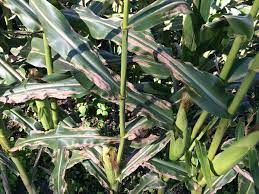
Northern corn leaf blight is caused by the fungus Exserohilum turcicum, and first appears on the lower blades at the time of silking or at full maturity It is characterized by narrow, 1 ” long, grayish tan lesions surrounded by a darker border. Lesions may also occur on leaf sheaths and husks. Infestations are usually worst in wet humid cool weather usually found late in the growing season. The disease is spread by the wind blowing spores among plants or from field to field. Photo Credit Daren Mueller, Iowa State University, Wikipedia
Control:
- Remove infected plants immediately and dispose of them so that the spores of the fungus can not spread.
- Wash tools, hands, and clothing that may carry spores.
- Use resistant cultivars
- Crop rotation
- Water in the morning using drip irrigation to reduce the time that moisture is on the leaves
- Mulch plants to reduce the effects of rain splashing spores onto plants
- Increase air circulation by increasing space between plants or trimming excess foliage
- Spray with a solution of 1 tablespoon baking soda, 2 1/tablespoons vegetable oil, and 1 teaspoon of liquid soap (not detergent) per gal of water. Repeat every 2 weeks, more often if rain washes the solution away.
- Spray with a prepared solution of Bacillus subtilis about every 2 weeks or when rain has washed it off the leaves.
- For very severe infestations spray with copper or sulfur, heeding cautionary warnings on the containers. The copper application will require special equipment.
t